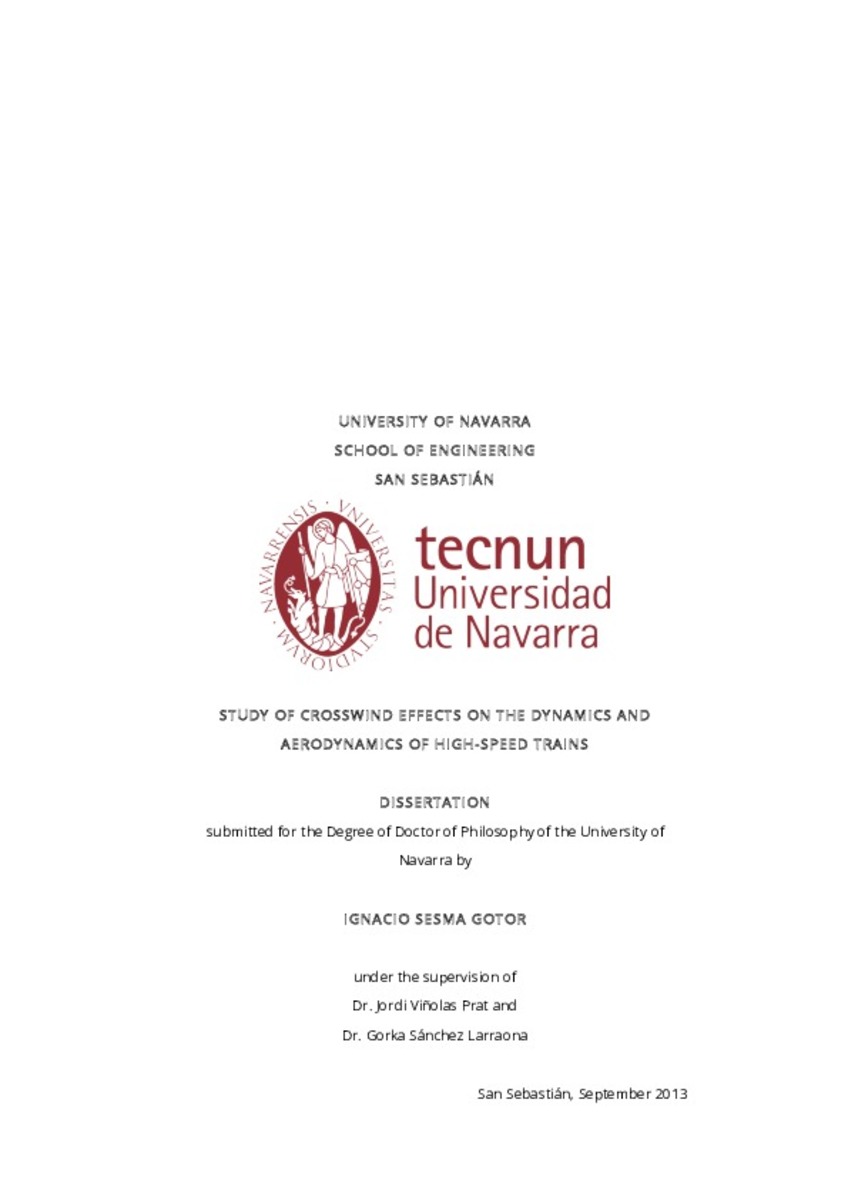Full metadata record
| DC Field | Value | Language |
|---|---|---|
| dc.contributor.advisor | Viñolas-Prat, J. (Jordi) | - |
| dc.contributor.advisor | Sanchez-Larraona, G. (Gorka) | - |
| dc.creator | Sesma-Gotor, I. (Ignacio) | - |
| dc.date.accessioned | 2013-10-10T09:41:38Z | - |
| dc.date.available | 2013-10-10T09:41:38Z | - |
| dc.date.issued | 2013-10-10 | - |
| dc.date.issued | 2013 | - |
| dc.date.submitted | 2013-09-27 | - |
| dc.identifier.citation | SESMA GOTOR, Ignacio ""Study of crosswind effects on the dynamics and aerodynamics of high-speed vehicles"". Sanchez Larraona, Gorka y Viñolas Prat, Jordi. Tesis doctoral. Universidad de Navarra, 2013 | es_ES |
| dc.identifier.uri | https://hdl.handle.net/10171/34161 | - |
| dc.description.abstract | The research on the crosswind field on the circulation of railway vehicles became noteworthy in the 90s with the development of high-speed trains. The European project TRANSAERO (Schulte-Werning et al., 2002) was the starting point since it was able to attract the attention of both the scientific community and the rolling stock manufacturers. Crosswinds are a safety matter and one of the key factors that are able to stop the continuous speed increase requested to the rail transportation. The study of the effect of crosswinds on vehicles problem requires a global vision since it involves both the dynamics and the aerodynamics of the vehicle. It is a coupled problem that requires a multidisciplinary approach and therefore the thesis addresses the problem from both perspectives. The sections centered on the vehicle dynamics firstly study 2D models and their benefit to extract conclusions in regard to the vehicle safety and comfort. The wheel unloading ratio is the factor used by standards to guarantee the safeness of the vehicle in the crosswind context. Conclusions show that a simplified model is able to provide wheel unloading factors with small rates of error. Moreover, crosswinds can also become a problem from the point of view of the vehicle’s comfort. By using full multibody models, we checked that the case of circulation on a curved track under lateral wind sets especially adverse conditions that can constraint the vehicle to reduce the travel speed in cases of high wind speeds. We observed that the vehicle described a yawing movement that made it to become instable, which reduced significantly the ride quality. The thesis describes previous aerodynamic research on the three-dimensional flow around high-speed trains in a crosswind scenario. However, the effect of the infrastructure is important and any modification at the surroundings of the vehicle alters the flow. At this respect, the thesis studies the sheltering effect of wind fences. Firstly, 2D computations have been used to carry out a parametric study of the fence design and to validate the value of simplified models. This work shows that 2D models are valid to find a set of fence designs to carry more detailed simulations in the 3D space. The goal of measuring the sheltering effect of wind-breaking devices in the 3D space was to obtain the aerodynamic coefficients of the vehicle using some of the fence designs that were used in the 2D model. The proposal herein presented is based on the use of a meshless CFD (Computational Fluid Dynamics) code that is based on the Lattice-Boltzmann Method (LBM). Results prove that these codes provide results with a reasonable margin of error at the range of yaw angles of interest for this investigation. | es_ES |
| dc.language.iso | eng | es_ES |
| dc.publisher | Servicio de Publicaciones. Universidad de Navarra. | es_ES |
| dc.subject | Train dynamics. | es_ES |
| dc.subject | Train aerodynamics. | es_ES |
| dc.subject | Crosswind stability. | es_ES |
| dc.subject | Computational fluid dynamics. | es_ES |
| dc.subject | Simplified models. | es_ES |
| dc.title | Study of crosswind effects on the dynamics and aerodynamics of high-speed vehicles. | es_ES |
| dc.type | info:eu-repo/semantics/doctoralThesis | es_ES |
Files in This Item:
Statistics and impact
Items in Dadun are protected by copyright, with all rights reserved, unless otherwise indicated.






